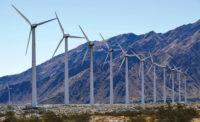Despite frequent news accounts of Chinese cities choking on fossil-fueled air pollution the country's renewable energy sector continues to progress. China leads the world in photovoltaic capacity, achieving 43 gigawatts in 2016. It overtook Germany for the top spot in 2015 after increasing the solar industry's capacity at the rate of 40% per year for over a decade.
China is now racing to become the world's biggest carbon trading market. It introduced carbon trading as a pilot project last year when 120 million tons of carbon dioxide worth 3.2 billion yuan ($463 million) had already been traded. The project will be extended to the entire country this year, and this will make China the world's biggest market, Xie Zhenhua, China's special representative for climate change affairs, said.
China's success has attracted Apple Inc., which recently bought a 30% stake in four wind power projects owned by Xinjiang Goldwind Science & Technology Co., China's biggest wind turbine manufacturer, as part of its efforts to minimize its carbon footprint.
"This is an image booster for both companies," says Zhou Yiyi, an analyst at Bloomberg New Energy Finance based in Shanghai. "It will indirectly offset Apple's carbon footprint linked to manufacturing in China through offsite power generation, as well as benefit Goldwind's exports."
Solar panel manufacturers from China have built up strong presence in the Middle East, North Africa, and South Asia markets. Their strategy involves making large-scale investment in foreign solar farms, using their own products.
The Gulf Cooperation Council (GCC), comprising all the Arab countries of the Persian Gulf except Iraq, offers a lucrative opportunity. GCC members in aggregate are expected to increase installed solar capacity 50-fold between 2015 and 2025. Saudi Arabia alone has announced plans for an additional 9.5 GW of renewable energy by 2030. Outside the GCC, India is targeting 175 GW by 2022, including 100 GW of solar. Li Dan, Vice Executive Secretary-General, Chinese Renewable Energy Industries Association, said these countries are gradually shedding their preference for western suppliers.
“Looking ahead, decisions will be based on purely commercial factors. Chinese companies can provide the quality, the capacity, and the commercial viability to put renewables at the center of the energy mix,” she said.
Inside China
The renewable sector accounts for one fourth of the total electricity production in China. Hydroelectricity took the lead contributing 20% to the total electricity generation in 2015, the last year for which detailed figures are available.
Wind farms contributed 3.3%, solar farms 0.7% and 0.9% came from biomass power plants. The government has set a target of raising non-hydro renewable power generation from five percent now to nine percent by 2020. The government wants companies to install 110 gigawatts (GW) of solar capacity by 2020. China invested $100 billion on renewable energy in 2016, and plans to intensify its investments year on year.
"During the period of the 13th Five-Year Plan (from the present to 2016-2020), we assume a coordinated development of the power grid on regional and provincial levels to be able to integrate on the order of 300-350 GW of wind power and 200-220 GW of solar power," China National Renewable Energy Centre said in its report, “China Renewable Energy Outlook 2016.”
By 2030, the China grid would basically be built out, effectively integrating all produced renewable power generation as an energy-friendly internet-like smart grid, according to the report.
Despite recent progress, there is grave dissatisfaction within China about the tardy growth in solar and wind power, which have failed to contribute enough.
These industries depend heavily on a government backed pricing mechanism, which will be phased out gradually starting with a 25% reduction in subsidies this year. Wind and solar together will lose $864 million in 2017, with deeper reductions scheduled in the following years.
Analysts cite the gradual withdrawal in subsidies as the main reason driving Chinese solar and wind power companies abroad. Inadequate linkage with the state grid and countrywide power transmission networks is seen as one of the hurdles.
Nearly 34 billion kilowatt-hours of wind power produced in 2015 were idled for want of takers. Similarly, solar farms could not sell 5 billion kwh of generation in 2015, the government's energy department said.
One of the major solar panel makers, ReneSola Ltd., recently unveiled an ambitious program to produce 335MW of electricity by building rooftop solar plants in major industrial units. The idea is to encourage them to meet a part of their electricity needs from the rooftop plants. The idea is to sell power directly to end users instead of going through the state grid.
The Trump effect
The renewables business has been worried about whether U.S. President-elect Donald Trump would go ahead with his election promise to scuttle implementation of the Paris Climate Change agreement. If the U.S. follows this course, China would be under much less pressure to reduce its carbon emissions. But Chinese officials say they will stick to their stated plans to move aggressively to replace fossil fuels with renewable energy. "As we speculate about what the United States might do, I hope the international community understands that China's position will not change," Gou Haibo, deputy head in the Chinese delegation on climate change talks, said.



Post a comment to this article
Report Abusive Comment